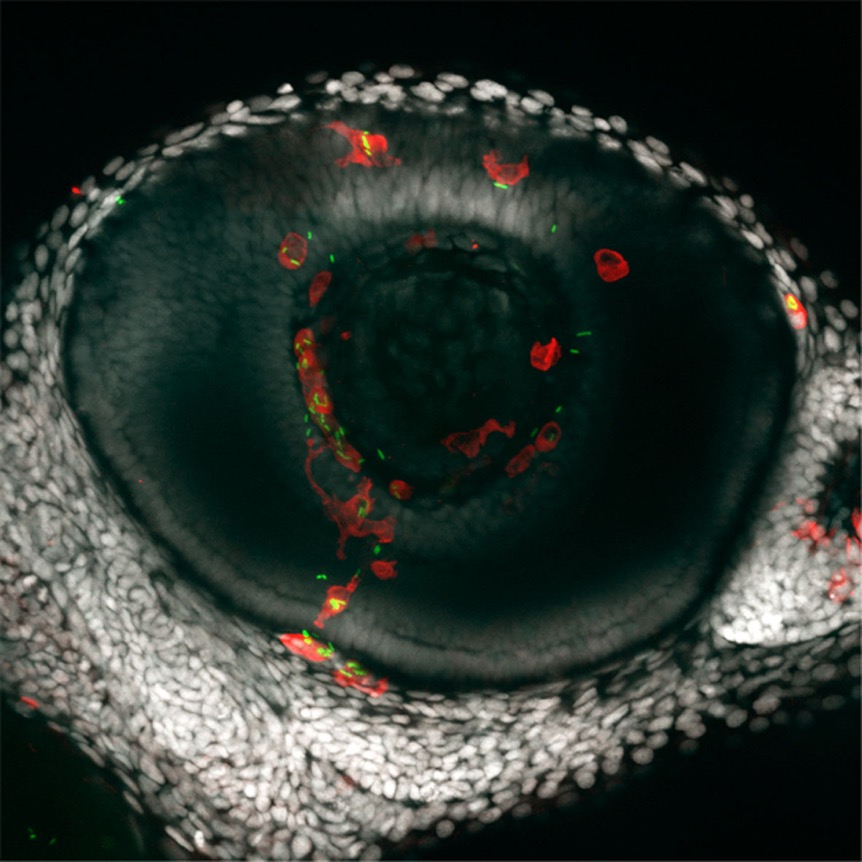Matthew A. Mulvey
Professor of Biological Sciences
Bacterial Pathogenesis, Innate Immunity, Antibiotics, Antibiotic Resistance, Urinary Tract Infection, Sepsis, Virulence Factors, Genetics, Cell Biology, Zebrafish, Infection

Molecular Biology Program
Education
B.S. University of Texas, Austin
Ph.D. University of Texas, Austin
Research
The Mulvey lab aims to define mechanisms by which pathogenic strains of Escherichia coli colonize diverse host niches, persist, and spread in the face of numerous environmental stresses, innate and adaptive host defenses, aggressive competition with other microbes, and exposure to antibiotics. We are especially interested in understanding how intraspecies genetic diversity and bacterial adaptive responses impact host-microbe interactions and the manifestation of variable disease phenotypes. Much of our work is focused on Extraintestinal Pathogenic Escherichia coli (ExPEC), which are leading causes of urinary tract and bloodstream infections. We have also recently initiated studies to define the pathogenic and survival mechanisms of diarrheagenic strains of E. coli, which are especially problematic and often lethal for children in developing countries. Our ongoing research indicates that even closely related bacterial strains can vary markedly in their ability to cause disease, dependent in part on host and environmental cues, input from neighboring microbes (the microbiota), and the specific gene sets carried by individual pathogens. To understand how environmental and evolutionary forces shape host-pathogen interactions, my lab employs a variety of experimental approaches and disciplines, including microbiology, microscopy, cell and molecular biology, biochemistry, bioinformatics, genetics, and genomics, as well as cell culture, mouse, and zebrafish models of localized and systemic infections. We also work closely with clinicians and bioinformaticists to identify and functionally define specific bacterial factors that impact the onset, progression, severity, and outcomes of diseases, including intestinal and urinary tract infections, meningitis, and sepsis.
Courses taught:
BIOL 2020, Principles of Cell Biology
References (Selected Publications)
- Bring Horvath ER, Stein MG, Mulvey MA,Hernandez EJ, Winter JM (2024).Resistance Gene Association and Inference Network (ReGAIN): A Bioinformatics Pipeline for Assessing Probabilistic Co-Occurrence Between Resistance Genes in Bacterial Pathogens. bioRxiv [Preprint]. 2024 Mar 1:2024.02.26.582197. doi: 10.1101/2024.02.26.582197. PMID: 38464005; PMCID: PMC10925210.
- Lewis AJ*, Richards AC*, Alejandra A. Mendez, Dhakal BK, Jones TA,Sundsbak JL, Eto DS, Rousek AA, Mulvey MA(2024).Plant Phenolics Inhibit Focal Adhesion Kinase and Ablate Host Cell Invasion by Uropathogenic Escherichia coli. Infect Immun. 27:e0008024. doi: 10.1128/iai.00080-24. PMID: 38534100. *Equal contributors.
- Munhoz DD*, Richards AC*, Santos FF, Mulvey MA#, Piazza RMF# (2023). coli common pili promote the fitness and virulence of a hybrid aEPEC/ExPEC strain within diverse host environments. Gut Microbes. 15(1):2190308. doi: 10.1080/19490976.2023.2190308. PMCID: PMC10038029.*equal contributors; #corresponding authors
- Fleming BA*, Blango MG*, Rousek AA*, Kincannon WM, Tran A, Lewis AJ, Russell CW, Zhou Q, Baird LM, Barber AE, Brannon JR, Beebout CJ, Bandarian V, Hadjifrangiskou M, Howard MT, Mulvey MA (2022). A tRNA modifying enzyme as a regulatory nexus for control of bacterial stress responses and virulence. Nucleic Acids Res. gkac116. doi: 10.1093/nar/gkac116. PMCID: PMC9303304. *equal contributors.
- Forde BM, Roberts LW, Phan M-D, Peters KM, Fleming BA, Russell CW, Lenherr SM, Myers JB, Barker AP, Fisher MA, Chong T-M, Yin WF, Chang KG, Schembri MA*, Mulvey MA*, Beatson SA (2019). Population Dynamics of an Escherichia coliST131 Lineage during Recurrent Urinary Tract Infection. Nature Comm., 10(1): doi: 10.1038/s41467-019-11571-5. PMCID: PMC6692316.*Co-corresponding authors.
- Brannon JR, Mulvey MA (2019). Jekyll and Hyde: Bugs with Double Personalities that Muddle the Distinction between Commensal and Pathogen.J Mol Biol., 431(16):2911-2913.
- Russell CW, Fleming BA, Jost CA,Tran A, Stenquist AT, Wambaugh MA, Bronner MP, Mulvey MA (2018). Context-dependent Requirements for FimH and Other Canonical Virulence Factors in Gut Colonization by Extraintestinal Pathogenic Escherichia coli. Infect Immun. 86(3): pii: e00746-17. PMCID:PMC5820936.
- Russell CW, Richards AC, Chang AS, Mulvey MA (2017). The Rhomboid Protease Glpg Promotes the Persistence of Extracellular Pathogenic Escherichia coli within the Gut. Infect Immun. 85(6):e00866-16. PMCID: PMC5442614.
- Wambaugh MA, Shakya VPS, Lewis AJ, Mulvey MA, Brown JCS (2017). High-Throughput Identification and Rational Design of Synergistic Small Molecule Pairs for Combating and Bypassing Antibiotic Resistance. PLoS Biol. 15(6): e2001644. https://doi.org/10.1371/journal.pbio.2001644. PMCID: PMC5478098.
- Barber AE, Fleming BA, Mulvey MA (2016). Similarly Lethal Strains of Extraintestinal Pathogenic Escherichia coli Trigger Markedly Diverse Host Responses in a Zebrafish Model of Sepsis. mSphere 1(2): pii: e00062-16. DOI:1128/mSphere.00062-16. Discussed on
- Barber AE*, Norton JP*, Wiles TJ, Mulvey MA (2016). Strengths and Limitations of Model Systems for the Study of Urinary Tract Infections and Related Pathologies. Microbiol Mol Biol Rev 80(2): 351-367. *Equal contributors. PMID: 26935136.
- Lewis AJ, Dhakal BK, Liu T, Mulvey MA (2016). Histone Deacetylase 6 Regulates Bladder Architecture and Host Susceptibility to Uropathogenic Escherichia coli. Pathogens. 5(1). 20; doi:10.3390/pathogens5010020.
- Russell CW and Mulvey MA (2015). The Extraintestinal Pathogenic Escherichia coli Factor Rqli Constrains the Genotoxic Effects of the RecQ-like Helicase RqlH. PLoS Pathogens. 11(12):e1005317.
- Blango MG, Ott EM, Erman A, VeranicP, Mulvey MA (2014). Forced Resurgence and Targeting of Intracellular Uropathogenic Escherichia coli PLOS One. 9(3): e93327.
- Barber AE, Norton JP, Spivak AM, Mulvey MA (2013). Urinary Tract Infections: Current and Emerging Management Strategies. Infect. Dis. 57:719-724.
- WilesTJ, Norton JP, Russell CW, Dalley BK, Fischer KF, Mulvey MA (2013). Combining Quantitative Genetic Footprinting and Trait Enrichment Analysis to Identify Fitness Determinants of a Bacterial Pathogen. PLOS Genetics.
- Debnath I, Barber AE, Dhakal BK, Kulesus RR, Norton JP, Mulvey MA (2012). The Cpx Stress Response System Potentiates the Fitness and Virulence of Uropathogenic Escherichia coli. Infect Immun. 81:1450-1459.
- WilesTJ, Norton JP, SmithSN, Lewis AJ, Mobley HLT, Casjens SR, Mulvey MA (2013). A Phyletically Rare Gene Promotes the Niche-specific Fitness of an coli Pathogen during Bacteremia. PLoS Path. 9(2):e1003175.
- Wiles TJ, Mulvey MA (2013). The RTX Pore-forming Toxin -Hemolysin of Uropathogenic Escherichia coli: Progress and Perspectives. Future Microbiol. 8(1):73-84.
- Donovan GT, Norton JP, Bower JM, Mulvey MA (2013). Adenylate Cyclase and the cAMP Receptor Protein (CRP) Modulate the Resistance and Virulence Capacity of Uropathogenic Escherichia coli. Infect Immun. 81(1):249-258.
- Jordan JP, Mulvey MA (2012). Toxin-Antitoxin Systems are Important for Niche-Specific Colonization and Stress Resistance of Uropathogenic Escherichia coli. PLoS Path 8(10):e1002954.
- Dhakal BK, Mulvey MA (2012). The UPEC Pore Forming Toxin a-Hemolysin Triggers Proteolysis of Host Proteins to Disrupt Cell Adhesion, Inflammatory and Survival Pathways. Cell Host Microbe 11:58-69.
- Blango MG, Mulvey MA (2010). Persistence of uropathogenic Escherichia coli in the face of multiple antibiotics. Agents Chemother. 54(5):1855-63.
- Wiles TJ, Bower JM, Redd MJ, Mulvey MA (2009). Use of Zebrafish to Probe the Divergent Virulence Potentials and Toxin Requirements of Extraintestinal Pathogenic Escherichia coli. PLoS Pathogens, 5(12):e1000697.
- Bower JM, Gordon-Ragaas, HB, Mulvey MA (2009). Conditioning of Uropathogenic Escherichia coli for Enhanced Colonization of the Host. Immun. 77(5): 2104-2112.
- Dhakal BK, Mulvey MA (2009). Uropathogenic Escherichia coli Invade Host Cells via an HDAC6-modulated Microtubule-dependent Pathway. Biol. Chem. 284(1): 446-454.
- Eto ES, Gordon HB, Dhakal DK, Jones TA, Mulvey MA (2008). Clathrin, AP-2, and the NPXY-binding Subset of Alternate Endocytic Adaptors Facilitate FimH-mediated Bacterial Invasion of Host Cells. Microbiol. 10(12): 2553-2567.
- Kulesus RR, Diaz-Perez K, Slechta ES, Eto DS, Mulvey MA (2008). Impact of the RNA Chaperone Hfq on the Fitness and Virulence Potential of Uropathogenic Escherichia coli. Immun. 76(7):3019-3026.
- Wiles TJ, Dhakal BK, Eto DS, Mulvey MA (2008). Inactivation of Host Akt/protein Kinase B Signaling by Bacterial Pore-forming Toxins. Biol. Cell, 19(4):1427-1438.
- Eto DS, Jones TA, Sunbdsbak JL, Mulvey MA (2007). Integrin-mediated Invasion of Host Cells by Type 1-piliated Uropathogenic Escherichia coli. PLoS Pathogens, 3(7):e100.
- Eto DS, Sundsbak JL, Mulvey MA (2006). Actin-gated Intracellular Growth and Resurgence of Uropathogenic Escherichia coli. Microbiol. 8:704-717.
